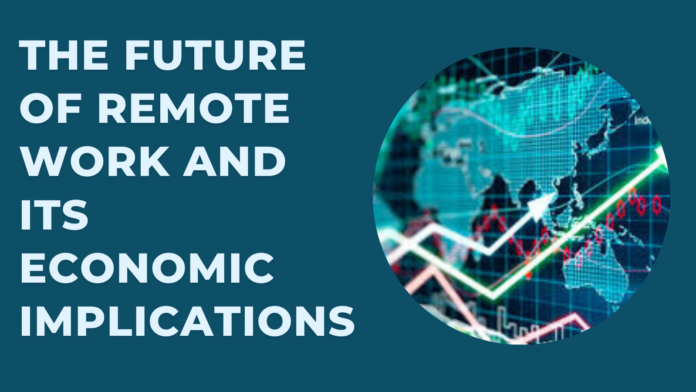Introduction to remote work and its growth in recent years
The landscape of work has undergone a seismic shift in recent years. Remote work, once a rare perk offered by select companies, is now the new normal for millions around the globe. The COVID-19 pandemic acted as a catalyst, propelling businesses and employees into virtual offices overnight. As we look ahead to what lies beyond this transformation, it becomes clear that remote work isn’t just a passing trend—it’s an evolving model that’s here to stay.
With its rise comes not only unprecedented flexibility but also significant implications for productivity and economic structures worldwide. Employers are rethinking traditional office spaces while employees navigate the challenges and benefits of working from home or anywhere else they choose. This evolution raises essential questions about how industries will adapt and thrive in this new environment.
In this exploration of the future of remote work, we’ll dive deep into its advantages, hurdles, economic impacts, future growth potential, and even government regulations shaping this movement. Buckle up as we embark on an insightful journey through the world of remote opportunities and challenges—it’s a ride you won’t want to miss!
Advantages of remote work for employers and employees
Remote work offers a plethora of advantages for both employers and employees. For businesses, it opens up access to a global talent pool. Companies can hire the best candidates regardless of their geographical locations.
Cost savings are another significant benefit for employers. With remote teams, overhead expenses like office space and utilities decrease substantially. This allows funds to be reallocated towards innovation or employee development initiatives.
Employees enjoy increased flexibility in their schedules. They can tailor their work hours around personal commitments, resulting in improved work-life balance.
Additionally, many workers report higher productivity levels when working from home. The absence of daily commutes and office distractions often leads to greater focus on tasks at hand.
Job satisfaction tends to rise as well; employees feel trusted and empowered in their roles while enjoying the comfort of familiar surroundings. This mutual advantage fosters a healthier workplace culture overall.
Challenges faced by companies and employees with remote work
Remote work, while beneficial, brings its own set of challenges for both companies and employees. One significant issue is communication. Without face-to-face interactions, misunderstandings can easily arise.
Isolation is another concern. Employees may feel disconnected from their teams, leading to decreased morale and engagement. This lack of connection can impact collaboration and creativity.
Companies also struggle with monitoring productivity effectively. Traditional oversight methods don’t translate well into a remote environment, creating uncertainty about employee performance.
Technology plays a big role too. Not everyone has access to reliable internet or suitable home office setups, which can hinder efficiency and cause frustration.
Setting boundaries becomes tricky when working from home blurs the lines between personal and professional life. Employees often find it difficult to “switch off,” which leads to burnout over time.
Economic impact of remote work on businesses and industries
The economic impact of remote work has been profound and multifaceted. Businesses have discovered significant cost savings by reducing overhead expenses related to physical office spaces. This shift allows companies to allocate resources more strategically.
Industries such as real estate are feeling the ripple effects, with a declining demand for commercial leases. Conversely, tech and digital service sectors are thriving, adapting swiftly to this new normal.
Remote work also opens doors for global talent acquisition. Companies can now hire skilled professionals regardless of their geographic location, enhancing diversity while filling critical roles efficiently.
On the flip side, local economies may suffer from reduced foot traffic in urban centers that rely on businesses catering to office workers. The balance between these benefits and challenges is delicate but vital for future sustainability in many industries.
The potential for future growth in the remote work industry
The remote work industry is on the brink of an exciting evolution. As technology continues to advance, companies are finding innovative ways to integrate remote working models seamlessly.
With improvements in communication tools and project management software, collaboration is becoming more effective than ever. This shift opens up opportunities for organizations to tap into global talent pools without geographical limitations.
Moreover, as businesses recognize the potential cost savings from reduced office space and overheads, many are reshaping their operational strategies around flexible work arrangements.
This trend isn’t just a temporary response; it’s a transformation that aligns with changing workforce expectations. Employees increasingly value flexibility and autonomy in their roles, driving demand for jobs that offer these benefits.
As we look ahead toward 2024 and beyond, the future of remote work appears promising—both for businesses aiming to adapt and workers seeking balance in their lives.
Government policies and regulations surrounding remote work
Government policies regarding remote work have evolved rapidly in response to changing workforce dynamics. Many countries are now considering legislation that addresses the rights of remote workers, including fair compensation and job security.
Regulations around workplace safety and ergonomics are also becoming crucial. Employers may be required to ensure safe home office setups, which can add a layer of complexity to compliance efforts.
Data privacy is another hot topic. Governments are focusing on how companies protect sensitive information when employees work from various locations. This means stricter guidelines for data handling practices might soon emerge.
Tax implications for remote workers present yet another challenge. Some states or countries may impose new tax regulations based on where employees reside versus where their company is headquartered.
As these policies continue to take shape, both employers and employees must stay informed about changes that could impact their working arrangements significantly.
Conclusion: How remote work will shape the future of work and economies worldwide
The landscape of work is changing. Remote work, once a temporary solution, has now cemented its place in the future of work. Its influence extends beyond individual employees and companies; it reshapes entire industries and economies.
As businesses adapt to this new model, they will find innovative ways to manage their remote teams effectively. The rise of productivity tools for remote workers demonstrates an ongoing commitment to efficiency and collaboration from anywhere in the world. Employers can tap into a global talent pool, while employees enjoy flexibility that traditional office settings can’t provide.
However, challenges remain. Balancing employee well-being with performance metrics is critical as organizations navigate this uncharted territory. Policies must also evolve to address concerns around data security and equitable access to resources.
Government regulations will play a significant role in supporting or hindering this shift toward remote work. As legislation catches up with reality, we may see more formal recognition of rights specific to remote workers.
The future holds promise for those willing to embrace change fully—both employers who adapt their strategies and individuals ready for remote opportunities that offer greater freedom than ever before. With continued innovation at our fingertips, the evolution towards hybrid models suggests another layer yet untapped where both on-site presence and virtual capabilities flourish side by side.
Remote work isn’t merely about working from home; it’s about redefining how we perceive productivity and teamwork across geographies. It invites us all into conversations about what work means today—and crucially—what it could mean tomorrow for economies worldwide.


